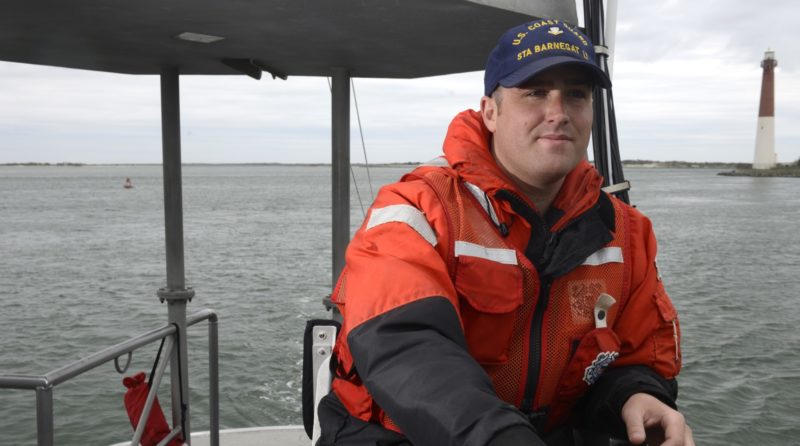A rescue of a man attempting a trans-Atlantic rowboat crossing and caught in a northeast gale has earned a Coast Guard surfman the service’s annual award for small-boat handling and leadership.
Petty Officer 2nd Class Eric Thornton’s duty section at Station Barnegat Light, N.J., launched their 47’ motor lifeboat June 3, 2018, when the Coast Guard Rescue 21 system directed them to a mayday call from rower Duncan Hutchinson, beset by heavy seas in a nor’easter about 20 miles off the New Jersey coast.
Hutchinson had just launched his trans-Atlantic attempt from New York Harbor, a 3,200-mile expedition to raise money for WaterAid, a charity that provides safe water and sanitation to impoverished communities around the globe. Hutchinson, a 52-year-old offshore oil worker, designed and built the vessel to make the crossing from the U.S. to his native Scotland.
Thornton, who hails from Turlock, Calif., and is a qualified Coast Guard surfman and boatswains’s mate, took his crew out Barnegat Inlet into 12’ breaking waves to locate Hutchinson. They got the rower safely aboard and returned to make a challenging transit over the Barnegat bar, pursued by 12’ to 14’ breaking waves.

Duncan Hutchinson on his rowboat Sleipner in New York Harbor at the start of his 2018 trans-Atlantic crossing attempt. Duncan Hutchinson via Facebook.
The rescue was just one of the cases that earned Thornton the 2018 Coast Guard Cdr. Ray Evans Outstanding Coxswain Trophy, which distinguishes one coxswain in the Coast Guard for their skill of operating boats, leadership and exceptional performance.
“Personally, this means the world to me,” Thornton said in a statement announcing the award this week. “It’s truly an honor and something I would have never believed that I would obtain during my career, and I’m beyond humbled by it.”
“Petty Officer Thornton did a flawless job on his search and rescue cases which went into his selection for the Cdr. Ray Evans award,” said Chief Warrant Officer Paul Ashley, the commanding officer at Barnegat Light. “Two of the three cases that were highlighted in the award submission required him to make judgement calls during times of limited communication, which integrated his instinctual calmness and sound decision-making as well as training.”
Ashley says that since Thornton arrived at the station, he has remained a humble person who has proved himself time and time again in challenging cases and weather scenarios, and whose approachable and friendly personality lends itself to him helping new members to the station.
“This was 100% a surprise to me,” Thornton said. “I heard I might have been put in for the trophy, but I was in California when I was told I would be receiving a phone call from Mr. Ashley. When I talked to him he said there was someone who would like to speak to me and it was Adm. Keith Smith, the 5th District commander on the phone congratulating me for being selected. The only words I could muster up was that I was truly honored.”
Throughout 2018, Thornton distinguished himself by amassing 305 underway hours during 156 sorties and took part in 23 search and rescue cases resulting in saving 13 lives and $289,345 in property.
Chief Petty Officer Robert Shay, the executive petty officer at Barnegat Light, says that Thornton’s performance while driving boats and leading crews through heavy surf, a skill that requires great attention and skill of watching and creating a strategy for navigating waves, is phenomenal.
“For me, what stands out about Eric is his calmness,” said Shay. “You really have to be even-keeled under pressure type of person as a surfman, and he carries that not only in the surf, but his approach to everything in life.”
Thornton says that for him the people who helped shape his career were his mentors both in Oregon and in Barnegat Light, as well as the National Motor Lifeboat School, which he said taught him skills that he still uses to this day for surf and heavy weather navigation.
“The biggest thing for me is first and foremost, no matter how many good things happen, stay humble and pass your knowledge down to the next person in line,” said Thornton. “That’s what people did for me and it’s what I do for the next people in line.”
As for Hutchinson, a second attempt on his rowboat Sleipner got him within 1,000 miles of Scotland, surviving big waves, storms and even a shark attack. But the boat’s electronic and navigation systems failed and he was picked up by a tanker Sept. 22.
The Sleipner survived, and washed ashore in Norway almost six months later. Hutchinson determined to fulfill his rowing commitment for the fundraiser, completing the 1,000 miles left on gymnasium rowing machines – mostly in the exercise spaces on the oil platforms where he works.
The Cdr. Ray Evans Outstanding Coxswain Trophy is named after Coast Guard Cdr. Ray Evans, a Signalman 1st Class and recipient of the Navy Cross during World War II, who served alongside Douglas Munro, the Coast Guard recipient of the Medal of Honor. The Coast Guard crew was on a Higgins boat during the battle for the island of Guadalcanal on Sept. 27, 1942, putting down covering fire as the 1st Battalion, 7th Marines fought Japanese troops on the beach. Evans remained at his post through the entire operation and with every other member of his crew killed or wounded, he maintained control of the boat with one hand while firing his machine gun with the other until the last boat cleared the beach.





